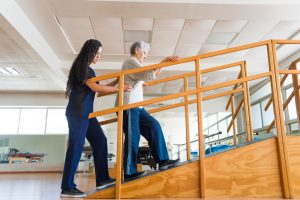
Low Impact Exercises for Rehabilitation
Treatment GuidelinesLow impact exercises are essential for post-injury recovery. Doing too much too fast can cause re-injury, and can prolong or inhibit the healing process. Simple, low impact exercises can provide many benefits and will encourage the healing process.
Rehabilitation programs are used to help restore proper function to a specific area of the body. Low impact exercises and workout plans, in particular, can be beneficial in rebuilding strength, improving flexibility and increasing range of motion after an injury to the musculoskeletal system. Low impact exercises can be an effective part of any rehabilitation program.
Yoga
Yoga can be very beneficial to low impact rehab by limiting joint stress and allowing you to move slowly through the workout without overly straining your muscles. Be sure to find a practitioner who specializes in corrective yoga therapy. Yoga involves stretching and holding certain poses while performing specific breathing exercises that help restore oxygen levels in the blood. Yoga also improves circulation and helps nourish damaged tissues. When appropriate, yoga can be performed at a patient’s comfortable, safe pace, helping the body not only regain its strength, but also aiding in the healing process. Yoga and Pilates both are exceptional low impact exercises that may complement almost any other exercise to increase efficiency and maximize the benefits patients receive from their workouts.
Swimming
Swimming is another good option for certain low impact rehabilitation. The buoyancy water provides relieves pressure on the joints, while the resistance of the water works all of the muscles, not just the ones targeted during “land” exercises. Swimming and aqua aerobics also have a positive effect on the cardiovascular system, forcing the heart to work more efficiently during the period of time the patient spends in the water. If patients don’t feel strong enough to swim laps in the beginning, simply walking from one side of the pool to the other will provide results.
Cycling
Stationary bikes can be included for patients who have knee or ankle problems. The bike requires very little force and there is limited impact placed on the joints. Newer models have variable programs built in that allow you to adjust speed, incline, and resistance, as well as a timer that can be set for a specific duration. Incorporating an exercise bike allows a patient to interchange walking and cycling. This keeps workouts interesting and will keep them motivated toward completing their rehab program.
Walking
Walking is the most common of all the low impact exercises, and can be included in workouts both at the facility and at home. Walking a short distance every day will work wonders in kick-starting the healing process and strengthening damaged tissues. If you walk outside, small grades or slopes can be used to add a small amount of resistance, but keep the grade lower than 10% to prevent the stair climbing effect. Walk with your kids or grandkids. Walk instead of driving. Walking saves money, strengthens the muscles, improves balance, and helps to restore muscle memory.
Low impact exercises are essential when beginning to exercise during post-injury recovery. Doing too much too fast can cause re-injury, and can prolong or inhibit the healing process. Simple, low impact exercises can provide many benefits and will hasten the healing process – reducing recovery time and getting the patient back on his or her feet, resuming their day-to-day activities.





